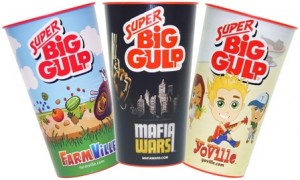Among my different jobs is one that takes me to public middle schools to teach creative and academic writing. In those classrooms, I have discovered that the craptastic school lunches I sometimes ate while that age are nothing compared to the contemporary dining habits of the Bronx’s eleven-to-thirteen set. Oversized plastic cups of sugared coffee slushy and a few Dunkin donuts, as well as the bags of Skittles or Doritos that were less of a surprise, are routine. Of course, I had a class at one of those schools whose lunch period began at 9:10, just after first period. It’s safe to say that our kids are both getting and seeking a raw deal.
And that takes us to Michael Bloomberg, who in spite of getting the law changed so he could have a third term, seems likely to go down in history mostly for banning smoking in bars, making us a more bike-friendly city (!), and trying to outlaw oversized soda containers in certain types of business.
I presume the soda ban is national news; I can’t imagine the Glen Becks of the country passing up such an opportunity. And so I’ve scrounged up a few key pieces of soft drink history:
The first known soft drinks were made in Paris in the 17th century. In 1676, the Compagnie des Limonadiers was granted a monopoly to dispense from tanks on its vendors’ backs a mix of water, lemon juice, and honey. This was a soft drink only in the broadest definition, which defines the beverage as a flavored, sweetened water. We all know sodas as carbonated, though, and that hit the scene in 1767 when an Englishman named Joseph Priestly (ancestor of hunky Jason?) discovered how to infuse water with carbon dioxide. He published his findings in a paper titled Impregnating Water with Fixed Air.
Boom!
From there on out, it was just a matter of improving the mechanization of chemistry and sussing out the public’s tastes. A Swedish chemist invented a machine that used chalk and sulfuric acid to produce large quantities of carbonated water. Another Swede started adding spices and juices for flavoring. In 1806, a Yale chemistry prof invented the soda fountain and in the 1830s both a New Yorker and a Philadelphian built factories that turned out large numbers of them. No one could figure out how to safely seal carbonated water in bottles, so those fountains at pharmacies and ice cream parlors became ubiquitous across the American landscape. One of those pharmacies was Morrison’s Old Corner Drug Store in Waco, Texas, and a pharmacist there made a hobby of concocting flavor combinations for customers. One, which his customers called simply “a Waco,” became incredibly popular, and in 1885, his boss named it in honor of a friend, Dr. Charles Pepper. Dr. Pepper remains the oldest soft drink manufacturer in the world.
A race to discover an effective cap or lid for soda bottles was on. In the later years of the 19th century, 1,500 patents were filed, but the first successful one was the Crown Cork Bottle Seal, developed by a Baltimore machinist in 1892. His design is still used today. (He also developed an ejection seat for passenger trains; I don’t know how that one panned out.)
The first machine that blew glass bottles was developed in 1899, and glass bottle production increased from 1,400 bottles to 58,000 bottles a day. Two decades later the modern six pack (and creative commercial misspelling pioneer), the Home-Pak, was devised, as well as the first vending machines. Coca-Cola hit Europe at Normandy and spread across the land with the promise of a Yankee smile and safety from homicidal insanity. Hearts and minds were being won at redonculous speed.
In 1952, a pair of Russian immigrant Brooklynites invented No-Cal, the first diet soda (a ginger ale) as an alternative soft drink for diabetics. Kim Novak stumped for it in print ads. Five years later, the first aluminum cans were used for soft drinks, and in 1970 the first plastic bottles were introduced to the industry.
And ten years after that, the Big Gulp landed on Planet Earth. At the moment, 12 years into the 21st century, the Big Gulp ranges from 20 to 64-ounce incarnations, making it sodanum non grata in Bloomberg’s New York.
Jon Stewart recently noted that Mike’s law “would combine the draconian government overreach people love with the probable lack of results they expect.” Sounds a bit, incidentally, like a summation of the current state of our public schools. But that’s for a different blog. I’m going to go hunt down a root beer.

